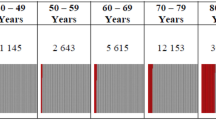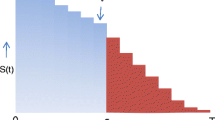Abstract
Valuation formulas for age-specific mortality risks are derived from life-cycle allocation theory under uncertainty and related to empirical estimates of the value of life. A change in an age-specific mortality risk affects all subsequent survivor functions and reallocates consumption and labor supply over the entire life cycle. The value of eliminating a risk to life at a specific age is the expected present value of consumer surplus from that age forward. Approximate numerical extrapolations from cross-section estimates imply that values decrease rapidly in current age and in the distance between current age and age at risk.
Similar content being viewed by others
References
Arthur, W. Brian. The Economics of Risks to Life.American Economic Review (Vol. 71, 1981), pp 54–64.
Bailey, Martin J.Reducing Risks to Life: Measurement of the Benefits. Washington, D.C.: American Enterprise Institue Study, No. 243, 1980.
Bergstrom, Theodore C. Preference and Choice in Matters of Life and Death. In: Jack Hirshleifer, Theordore C. Bergstrom, and Edward Rappaport, eds.,Applying Cost-Benefit Concepts to Projects Which Alter Human Mentality. Research Report, UCLA School of Engineering, 1974.
Bergstrom, Theodore C. Soldiers of Fortune. In: W.P. Heller, R.M. Starr and D.A. Starret, eds.,Social Choice and Public Decision-Making: Essays in Honor of Kenneth Arrow, Vol. 1. Cambridge: Cambridge University Press, 1986.
Conley, Brian C. The Value of Human Life in the Demand for Safety.American Economic Review (Vol. 66, 1976), pp 45–55.
Cropper, Maureen L. Health, Investment in Health and Occupational Choice.Journal of Political Economy (Vol. 85, 1977), pp 1273–1294.
Ehrlich, Isaac & Chuma, H. The Demand for Life: An Economic Analysis. University of Buffalo, 1984.
Jones-Lee, M.W..The Value of Life: An Economic Analysis. Chicago: University of Chicago Press, 1976.
Marshall, John M. Gambles and the Shadow Price of Death.American Economic Review (Vol. 74, 1984) pp 73–86.
Mishan, Ezra J. The Evaluation of Life and Limb.Journal of Political Economy (Vol. 79, 1971) pp 687–705.
Moore, Michael J. & Viscusi, Kip W. The Quantity Adjusted Value of Life.Economic Inquiry, 1988 forthcoming.
Peltzman, Sam. An Evaluation of Consumer Drug Protection Information: The 1962 Drug Amendments.Journal of Political Economy (Vol. 81, 1973), pp 1049–1091.
Rice, Dorothy P.Estimating the Costs of Illness, Health Economics Series, No.6 Washington, D.C.; U.S. Public Health Service, 1966.
Rosen, Sherwin. Valuing Health Risk.American Economic Review (Vol. 71, 1981) pp 241–245.
Schelling, Thomas G. The Life You Save My Be Your Own. In: S.B. Chase, eds.,Problems in Public Expenditure Analysis, Washington, D.C.: Brookings Institution, 1986.
Shepard, Donald S. & Zeckhauser, Richard J. Survival Versus Consumption.Management Science (Vol. 30, 1984), pp 423–439.
Steuerle, Eugene & Hartzmark, Michael. Individual Income Taxation, 1949–79.National Tax Journal (Vol. 34, 1981), pp 145–166.
Thaler, Richard & Rosen, Sherwin. The Value of Saving A Life: Evidence from the Labor Market. In: N. Terleckyj, ed.Household Production and Consumption. New York: National Bureau of Economic Research, 1975.
Townsend, Robert. Arrow-Debreu Programs as Microfoundations for Macroeconomics. Discussion paper 86-7, Program In Quantitive Economic Analysis, National Opinion Research Center, 1986.
Usher, Daniel. An Imputation to the Measure of Economic Growth for Changes in Life Expectancy. In: M. Moss, ed.,The Measurement of Economic and Social Performance. New York: National Bureau of Economic Reasearch, 1973.
Viscusi, W. Kip. Wealth Effects and Earnings Premiums for Job Hazards.Review of Economics and Statistics (Vol. 60, 1978), p 408–416.
Viscusi, W. Kip. Insurance and Individual Incentives in Adaptive Contexts.Econometrica (Vol. 47, 1978), pp 117–140.
Weisbrod, Burton A. Costs and Benefits of Medical Research: A Case Study of Poliomyelitis.Journal of Political Economy (Vol. 79, 1971), pp 523–544.
Yaari, Menachem E. Uncertain Lifetime, Life Insurance and the Theory of the Consumer.Review of Economic Studies (Vol. 32, 1965), pp 137–150.
Additional information
The University of Chicago
This research was supported by the Environmental Protection Agency and the National Science Foundation, but neither agency is responsible for the contents of this paper.
Rights and permissions
About this article
Cite this article
Rosen, S. The value of changes in life expectancy. J Risk Uncertainty 1, 285–304 (1988). https://doi.org/10.1007/BF00056139
Issue Date:
DOI: https://doi.org/10.1007/BF00056139




